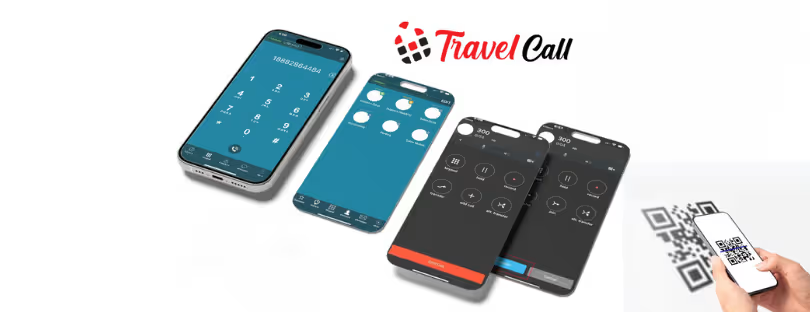
TravelCall Launches With Promises of Low-Cost Global Calling
International calling hasn’t changed much in decades. Prices are still unpredictable, roaming remains a wallet-drainer, and most travelers learn the hard way that answering a call abroad can cost more than the taxi from the airport. That’s the gap Vigil Inc Ltd is stepping into with the launch of TravelCall.app, a platform built to make cross-border communication simple and genuinely affordable—whether you’re sitting at home, working remotely, or waiting for a connection in an airport lounge. travelcall app cheap international calls
Vigil Inc, operating with more than a decade of hands-on experience in voice technology, has spent years studying where users lose money and where carriers gain it. The result is a product that tries to remove the noise from international communication: no new SIMs, no secondary devices, and no confusing tariff charts. Just cheaper calls routed through secure, internet-based channels.
The pain point is universal. In markets like India, consumers still pay anywhere from $0.20 to $2.00 per minute for international calls. Roaming adds another sting, often rising to $1–$3 per minute, and even receiving a call from home can trigger charges. TravelCall’s proposition—cutting costs by 70–90%—is immediately attention-grabbing.
TravelCall’s Value: Lower Costs Without Changing User Habits
The core idea is refreshingly straightforward: use your regular phone, your regular number, and dial internationally as you usually would—just at a fraction of the cost.
Users log in with their existing mobile number, and TravelCall routes calls via secure internet channels. Popular destinations can cost as low as $0.02 per minute, a striking contrast to most carrier-based international tariffs.
That low-friction experience is part of TravelCall’s positioning. Instead of marketing itself only to travelers (a common niche for apps built on internet calling), the platform recognizes that international calling affects a far wider base:
Who TravelCall is built for
- Families with relatives living abroad
- Students studying in Europe, the U.S. or Australia
- Remote workers collaborating across borders
- Small businesses with global clients
- Long-distance couples keep daily contact
- Frequent travelers who want to avoid roaming traps
At home, the benefit is clear: users finally get a way to call internationally without the anxiety of checking their next bill. Abroad, it’s even more impactful. Users can let incoming roaming calls ring unanswered, then call back instantly using WiFi or an eSIM data pack—without switching numbers or identities.
A Founder Story Rooted in Customer Experience
TravelCall also carries a founder narrative that shapes the ethos of the product.
Santhosh Kumar’s path didn’t start with global telecom partnerships—it started in a 10×10 room in Bangalore, where he converted a closed family restaurant into a small cyber centre in 2008. In the dial-up era, when queues for computer access were still a daily sight, he spent a decade helping people navigate the web, learn new tools and connect with the outside world. That customer-first mindset—“Customer Satisfaction Service,” as he describes it—became the foundation for the business that followed.
Alongside running the cyber centre, he built a small software team creating School Management and Supply Chain Management systems. A parallel opportunity supporting a U.S. telecom operator introduced him to international voice systems, carrier routing and the engineering of global telecom infrastructure.
Those experiences eventually evolved into Vigil Inc, headquartered in Hong Kong, and later VirtualGlobalPhone.com, providing VoIP services and virtual numbers. TravelCall.app represents the next phase of that long-running mission: simplifying global communication for regular people—not just enterprises.
How TravelCall Works in Practice
The mechanics are intentionally familiar:
- Login with your existing mobile number
- Use your regular smartphone
- Dial any international number
- Pay significantly lower rates
- Keep your real caller ID
Because the calls travel through secure internet routes rather than operator-controlled voice circuits, prices stay low and stable.
For users calling from home, it means slashing international expenses without switching plans or SIM cards. For travelers, it means finally escaping roaming charges—often the most unpredictable and painful part of any trip.
A traveler connected to hotel WiFi, airport WiFi, a café hotspot or an eSIM data pack can call any international number instantly. What would normally cost dollars per minute drops to cents.
No more searching for local SIM shops, no more juggling multiple numbers, and no more deciphering which roaming option is the “least expensive bad choice.”
Transparent Pricing in an Industry Known for the Opposite
Telecom bills have historically been opaque by design. TravelCall’s insistence on upfront, predictable pricing is a clear differentiator. Users know the rate before placing the call and are charged exactly what they see—no activation fees, no surprise add-ons, no roaming multipliers buried in the fine print.
This simplicity aligns with broader shifts in consumer expectations. Research from the GSMA and ITU consistently shows that users value clarity and predictability more than raw speed or even raw price. The global trend is toward platform-based communication tools that simplify rather than complicate.
TravelCall and the Future of Cross-Border Calling
It’s impossible not to compare TravelCall with other players in the space—apps like Rebtel, Vonage, TextNow, or even WhatsApp (though WhatsApp isn’t designed for real-number outbound calling). TravelCall’s edge is its hybrid approach: users keep their real number, call traditional phone lines, and avoid the “app-to-app only” limitation that makes many VoIP tools unsuitable for business or older relatives.
However, price leadership may be difficult to sustain. The VoIP market is competitive, wholesale rates fluctuate, and global carriers increasingly push their own “cheap international packs.” The platforms that will win long-term are the ones that balance cost with quality, consistency, and user trust.
TravelCall’s ambition to expand destination coverage, introduce smart routing and integrate local partners will determine how it positions itself in that evolving landscape.
Conclusion: Where TravelCall Fits in the Market
TravelCall enters the market at a moment when global connectivity is undergoing a major reset. eSIM adoption is reducing roaming dependency. WiFi-first apps are growing faster than traditional mobile plans. According to the GSMA’s 2024 Mobile Economy report and ITU cost analyses, consumers are steadily shifting to OTT calling solutions that prioritize transparency and flexibility.
Compared with established low-cost calling apps, TravelCall’s strength lies in its simplicity: real-number calling, no SIM swaps, and pricing that’s competitive even against the most aggressive MVNO international bundles. Its story—and its customer-first origins—give it an authenticity many telecom tools lack.
If Vigil Inc can maintain quality and continue expanding coverage, TravelCall has the potential to become a go-to option for anyone who still relies on traditional phone calls across borders. And in a market as fragmented and confusing as international calling, that clarity may be exactly what users have been waiting for.











